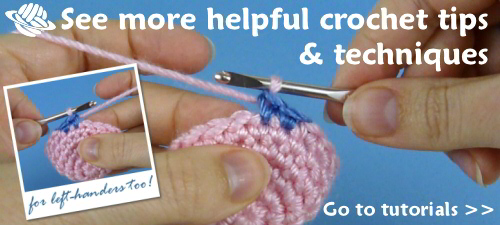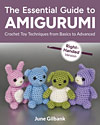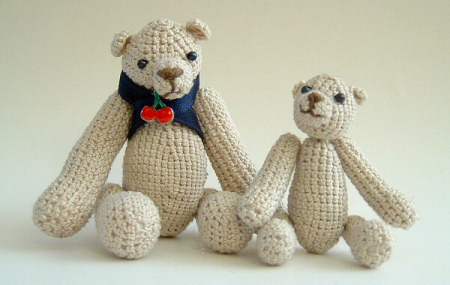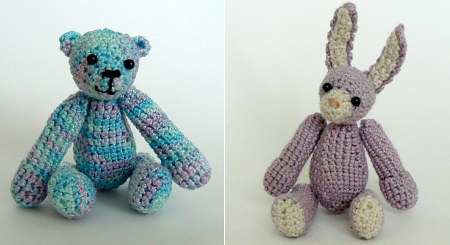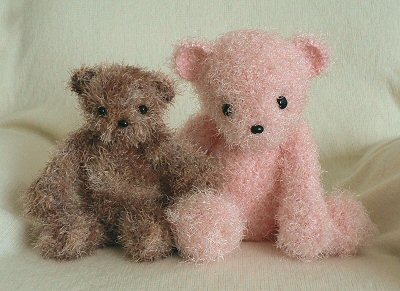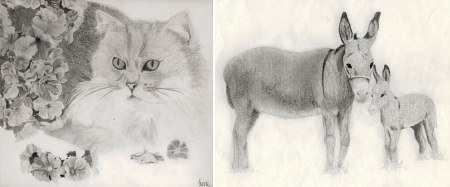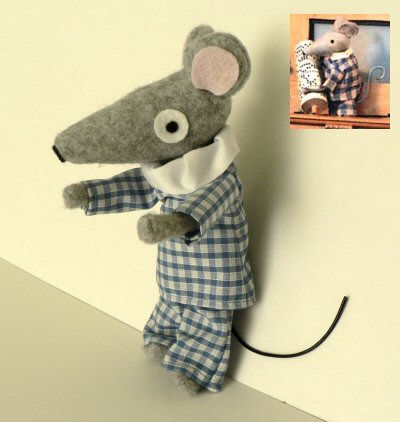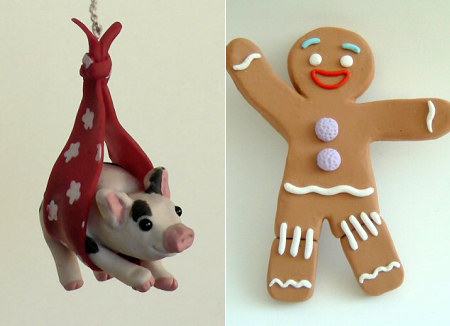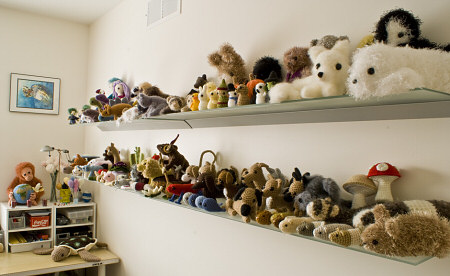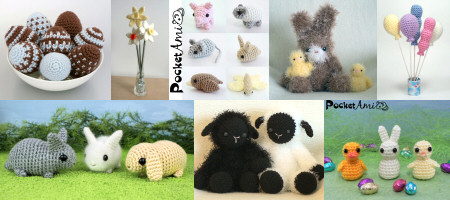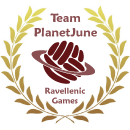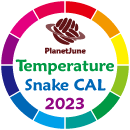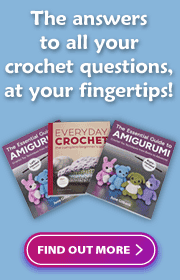Worsted weight acrylic yarn is what I use and recommend for my amigurumi designs. That’s 100% acrylic yarn, marked as worsted weight, medium weight, or number 4. (Outside North America, it may also be called 10 ply or aran weight.)
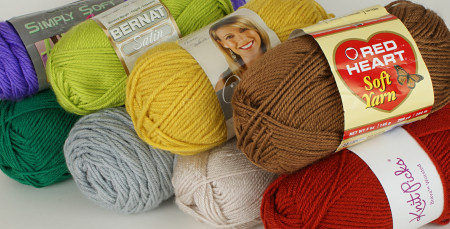
That makes it sound pretty locked down, and that any yarn you choose that fits those requirements will be exactly the same. Of course, if you’ve ever touched, let alone used, two brands of worsted weight acrylic, you’ll know that’s not the case. Thickness, loft (bounciness), stretchiness, softness, shininess – all these properties vary wildly between different yarns all marked as worsted weight acrylic, and that’s why I usually recommend that you don’t mix yarns within an amigurumi.
I thought it might be interesting to try to quantify some of this, as scientifically as possible. So, time for a yarn experiment!
The Contenders
I took 8 samples of worsted weight acrylic yarns, choosing a different colour for each so we can recognise them later:

- Lion Brand Vanna’s Choice (yellow)
- Caron Simply Soft (purple)
- Hobby Lobby I Love This Yarn! (grey)
- Patons Canadiana (beige)
- Red Heart Soft (brown)
- KnitPicks Brava (red)
- Loops & Threads Impeccable (green) – Michaels’ store brand
- Bernat Satin (lime)
Test 1: wraps per inch (WPI)
Yarn thickness is often measured in terms of wraps per inch (WPI). To find the WPI, you wrap the yarn around something (e.g. a ruler) so the wraps are touching but not squashed tightly together, and count how many wraps fit into 1 inch. A higher WPI number means a finer yarn.

Here there are 12 wraps between the 3″ and 4″ markers on the ruler.
My WPI results were consistently higher than the ones I found on Ravelry, e.g. Bernat Satin (pictured above) apparently has a WPI of 9, not the 12 I measured. But as I’m looking for a trend, not the actual numbers, that doesn’t matter – I measured each of my samples using consistent methodology, so the thicker yarns will have a smaller WPI number in my test.
Test 2: crocheted sample
I crochet with very consistent tension, as you can see by how even the stitches look in my amigurumi. So crocheting an amigurumi-style sample was the best way for me to ensure a consistent result for this test, plus it’s more relevant for amigurumi than a flat square swatch would be. I used an E (3.5mm) hook and crocheted a cup shape with each yarn, using the same pattern for each cup, and making sure the sample was large enough to measure the finished single crochet stitch width and height.

As you can see, the samples varied in size considerably:

These two samples were crocheted using the same hook and pattern, but the different yarns make a huge difference to the finished size! The Bernat Satin sample easily fits inside the Lion Brand Vanna’s Choice sample.
I flattened each cup to remove any inaccuracy from the 3D shape (it’s hard to measure an accurate diameter). To get an accurate measurement, I measured over 10 stitches and 6 rows to get my average stitch heights and widths.
An Aside: Watch Out!
Even within the same yarn, I’ve found that there can be slight thickness differences between different colours, but here’s an example of a larger difference: for years I’ve been talking with friends about how Bernat Satin seems thinner than it used to when I first started buying it, so I decided to try the WPI test with a sample of Bernat Satin that I bought in 2007.
After verifying that the change in the yarn was real (old WPI 11, new WPI 12), I checked the ball bands from several skeins of old and new Satin. All Bernat Satin has a weight of 100g, but the older balls were labelled as between 149 and 152m per 100g skein. All the newer balls are labelled as 182m per 100g skein. That’s 30 metres more yarn with the same total weight, which means the yarn really has got thinner (and the gauge information was never modified, although the gauge is definitely different since the change!)
So my little caution is to watch out – even if you’re buying the same brand and type of yarn, it may not have exactly the same thickness.
The Results
| Yarn |
Sample Colour |
WPI |
Stitch width / mm |
Stitch height / mm |
| LB Vanna’s Choice |
yellow |
11 |
6.2 |
5.5 |
| C Simply Soft |
purple |
13 |
5.4 |
4.8 |
| HL I Love This Yarn! |
grey |
12 |
5.9 |
5.0 |
| P Canadiana |
beige |
13 |
5.3 |
4.7 |
| RH Soft |
brown |
13 |
5.3 |
4.7 |
| KP Brava Worsted |
red |
13 |
5.6 |
5.0 |
| L&T Impeccable |
green |
11 |
6.3 |
5.5 |
| B Satin |
lime |
12 |
5.3 |
4.7 |
I arranged all the flattened samples by size here so you can see the difference visually too – 0.3mm per stitch may not sound like much, but you can see that it really makes a difference, even in a small amigurumi piece:

Flattened samples from the top – the height of the samples shows the stitch width variation
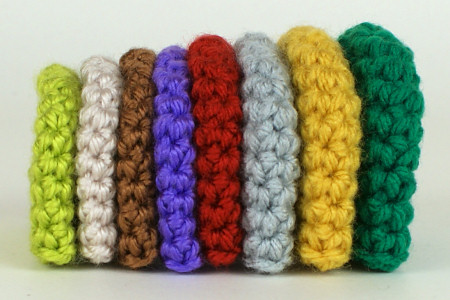
Flattened samples from the side – the height of the samples shows the stitch length variation
Now here’s the table again, this time with the yarns arranged in the same order as in the photos above. Italics show the thinnest yarns, and bold shows the thickest.
| Yarn |
Sample Colour |
WPI |
Stitch width / mm |
Stitch height / mm |
| B Satin |
lime |
12 |
5.3 |
4.7 |
| P Canadiana |
beige |
13 |
5.3 |
4.7 |
| RH Soft |
brown |
13 |
5.3 |
4.7 |
| C Simply Soft |
purple |
13 |
5.4 |
4.8 |
| KP Brava Worsted |
red |
13 |
5.6 |
5.0 |
| HL I Love This Yarn! |
grey |
12 |
5.9 |
5.0 |
| LB Vanna’s Choice |
yellow |
11 |
6.2 |
5.5 |
| L&T Impeccable |
green |
11 |
6.3 |
5.5 |
But it’s not just weight that plays a part; the yarns’ appearance and feel also vary. Old-fashioned acrylics felt hard and looked matte, whereas many modern ‘soft’ acrylics feel silkier to work with, and have more of a sheen to them. You may prefer a firmer, more rigid yarn for amigurumi, or like the shinier, softer look and feel. For me, I like both, but I’d never want to mix them in one project.
This final table of results is more subjective, but it’s my attempt to classify the yarns by which are similar enough to use within one project, both in terms of softness/shininess and weight. These are just my opinion, and I may have invented the term ‘light worsted’, but I feel it applies for subdividing the ‘worsted’ weight into strata of weights that match each other more closely.
| Yarn |
Sample Colour |
Shininess |
Weight |
| B Satin |
lime |
sheen |
light worsted |
| P Canadiana |
beige |
sheen |
light worsted |
| RH Soft |
brown |
sheen |
light worsted |
| C Simply Soft |
purple |
sheen |
light worsted |
| KP Brava Worsted |
rust |
slight sheen |
worsted |
| HL I Love This Yarn! |
grey |
slight sheen |
worsted |
| LB Vanna’s Choice |
yellow |
slight sheen |
heavy worsted |
| L&T Impeccable |
green |
no sheen |
heavy worsted |
So, I’d use any of the top 4 yarns (Bernat, Patons, Red Heart, Caron) interchangeably – they have a similar weight and sheen to them, and the size difference is no more than that between different shades of the same type of yarn. Of the remaining four, they make 2 pairs in terms of weight, but the KnitPicks and Lion Brand are far softer than the Hobby Lobby and Michaels’ store brands, and have more sheen, so I wouldn’t mix them.
Recommendations
- Although some worsted weight yarns are thicker than others, all make good amigurumi! The only difference is the size of the finished result – they will scale correctly so using the same pattern with a thicker yarn will give you a taller, wider and deeper amigurumi – it will remain in proportion to the original design.
- These results aren’t so important if you’re making simple amigurumi e.g. a brown bird with a yellow beak and feet, but if you’re making multi-coloured amigurumi with colour changes within the pieces, or more complex shaping, I recommend you use my results (and/or do your own test first), to make sure the yarns you’ve selected are comparable in thickness, feel, and appearance before you start.
- Don’t believe the gauge info when you’re comparing yarns for amigurumi! Only half the yarns I tested had crochet-specific gauge info, but according to those that did, you’d expect Vanna’s Choice (one of the heaviest yarns I tested) to be thinner than Red Heart Soft (among the lightest yarns in my test) – that’s clearly incorrect. The other gauge information (for recommended hook/needle sizes and knitting) seemed equally random/incorrect compared with my tests.
I hope you found my little experiment useful! I know it’s answered some questions for me, and now I’ll feel more confident about deciding to mix, or not mix, certain yarns in my future amigurumi projects.
Loved this tutorial? I have so many more amigurumi tips and tricks to share with you!
Boost your amigurumi skills with my latest book, The Essential Guide to Amigurumi, your comprehensive guide to amigurumi techniques and tips.
Do you find my tutorials helpful? If so, please consider making a contribution towards my time so I can continue to create clear and concise tutorials for you:
Thank you so much for your support! Now click below for loads more crochet video and photo tutorials (and do let me know what else you’d like me to cover in future tutorials…)
